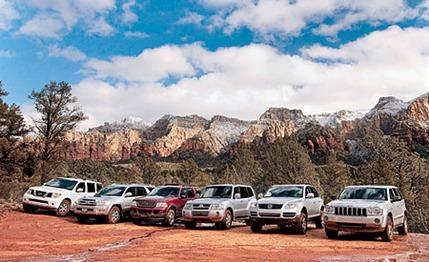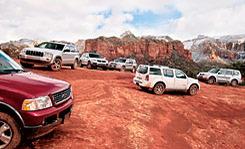
 Comparison Tests
Comparison Tests
Mother Nature started her landscaping for this comparison test 275 million years ago, when she washed a bunch of quartz sand with rusty water until the grains took on a pretty red hue and then cemented them together to form sandstone bedrock. Over the ages since, she hoisted this one-time sand pile upward by 4600 feet and set about sculpting it into a lofty lump that today's residents of Sedona, Arizona, call Chicken Point.
Not that most of them get to see this particular sample of her handiwork. Mother hid it well behind a spellbinding array of other rocks, all of which seem to have more appealing names.
Chicken Point is hidden but not forbidden. There's a trail — Broken Arrow — barely wide enough for one vehicle over most of its 2.1-mile length. Thrill-seeking visitors buy a ride in the Jeeps of a local tour company. But if you have a 4x4 and are willing to risk ripping the bottom out of it, you can attempt the journey yourself.
Hmm. Could we urge a six-pack of grocery getters up to Chicken Point without leaving 5W-20 slicks from savaged oil pans or embarrassing ourselves with a call for helicopter evacuation? Only one way to find out.
Exactly which SUVs? First, the all-important qualifier: The vehicles must have low and high ranges. Broken Arrow is a slow-speed trek demanding plenty of ground clearance and driver expertise.
The spring season has two all-new mainstreamer SUVs: the Jeep Grand Cherokee, now with Hemi power, and a Nissan Pathfinder built on Titan bones. Both have the climber's swagger. Toyota's athletic 4Runner is certainly right for the mission. The optional V-8 won't go breathless on us at altitude. The Mitsubishi Montero has intriguing off-road capability, too, including the ability to be shifted from rear drive to all-wheel drive on the fly at speeds up to 62 mph.
From VW, the agile Touareg might be pulled down to popular prices if we stay with the standard 237-hp, 3.2-liter V-6. We're aiming for a base sticker in the $35,000-to-$40,000 range.
What about the most ubiquitous SUV ever, 14 years as an American bestseller: the Ford Explorer? With two-wheel drive, it's as common as dandelions. Instead, we'll opt for AdvanceTrac full-time all-wheel drive and Roll Stability Control. The price? Uh, a blur of incentives lets you buy an Explorer right. And if these rebates were as predictable as, say, lunar cycles, we could pull them into our as-tested calculation. They aren't. We can't. Let's just say we welcome Mommy's favorite ballet bus to the climb, and if it can do a demi-plié on Chicken Point, there'll be high-fives in PTA meetings across the land.
At the risk of getting all Lewis-and-Clark on you, we hired a geologist to accompany us. Inquiring minds want to know why the rocks of Sedona are red, and why does that redness stop just beyond the edge of town?


Geologist Wayne Ranney explains rocks as if he had baked them himself. He helped us see that the red is really just a stack of layers about 1400 feet thick, situated partway up a much taller cliff. Look northeast of Sedona: The high ground is tan. Those lighter-colored layers above the red start about a mile above sea level; they covered Sedona thousands of years ago. Blame erosion? You could, or you could enjoy the carvings it leaves behind. From two fixed points just south of town — they happen to be old volcanoes — Ranney has calculated that Sedona's cliffscape is migrating northeast at the rate of one foot every 625 years.
The relatively soft rock — mostly sandstone — doesn't dissolve uniformly, however. Lumps and spires are left behind for our Kodak moments — the rock equivalent of slowly melting icebergs — and they are christened with fanciful names like Courthouse and Bell Rock.
Chicken Point is a formation still hidden in the background, biding its time as the rocks in front crumble away. In a few turns of geological time it, too, will be gone.
The rocks are melting, guys. Let's roll.